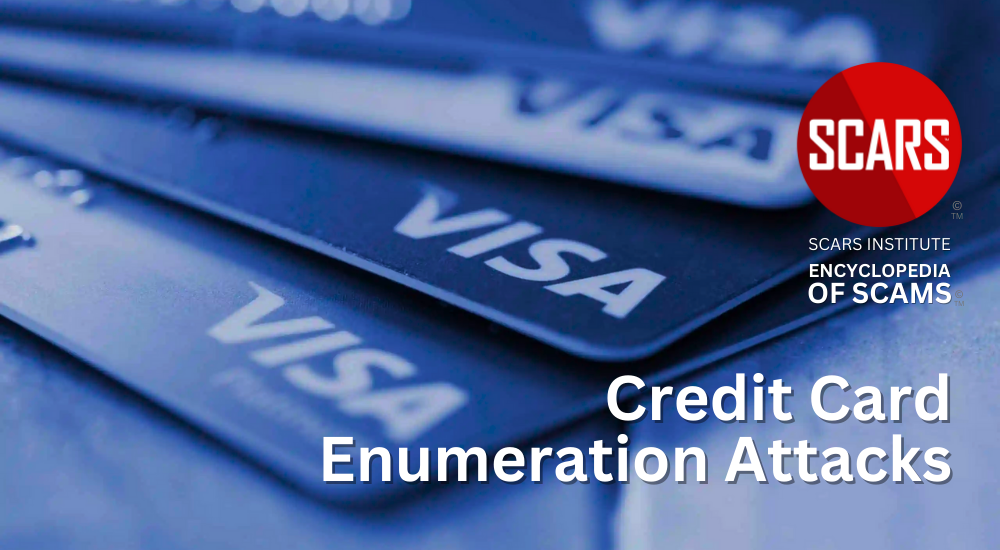Credit Card Enumeration Attacks – Stealing From Your Accounts
How Fraudsters Use Credit Card Enumeration Attacks to Steal Payment Data – and How to Protect Yourself or Your Business
How Scams Work – A SCARS Institute Insight
Author:
• Tim McGuinness, Ph.D., DFin, MCPO, MAnth – Anthropologist, Scientist, Director of the Society of Citizens Against Relationship Scams Inc.
Article Abstract
Fraudsters use enumeration attacks to systematically test combinations of credit card numbers, CVVs, and expiration dates by running small transactions, aiming to find valid card details.
These attacks often occur through merchants with weak fraud controls, allowing criminals to verify stolen card information and later conduct large-scale fraud.
To protect against such attacks, both businesses and cardholders must monitor for unusual transaction patterns, set strong fraud controls, and promptly address small unauthorized charges. Strengthening security practices like multi-factor authentication can help reduce the risk of these attacks.

How Fraudsters Use Credit Card Enumeration Attacks to Steal Payment Data – and How to Protect Yourself or Your Business
Fraudsters increasingly use enumeration attacks to steal payment data, exploiting legitimate businesses by methodically testing card numbers, expiration dates, and CVV codes through merchant payment systems. This is akin to picking a lock, one digit at a time. They often test small-dollar transactions to verify stolen card details before launching more extensive fraudulent activities.
Key Tactics Fraudsters Use to Steal from Credit Cards
- Enumeration Attacks: Fraudsters attempt multiple combinations of card details to find valid ones.
- Account Testing: Small transactions ($1–$2) test the validity of cards. Successful tests lead to large-scale fraud.
- Phishing or Merchant Account Takeovers: Criminals gain access to merchant accounts by phishing, taking over, or creating fake accounts.
- Clone Payment Devices: Fraudsters also use cloned payment terminals to bypass legitimate merchant channels.
According to VISA:
Threat actors are leveraging sophisticated technologies, like automated scripts and botnets, to amplify their card testing attacks, allowing them to exploit vulnerabilities at an unprecedented scale and speed. These attacks, known as enumeration attacks, inflict operational expenses and $1.1B annually in fraud losses, accounting for a significant portion of global fraud.
Enumeration can have lasting impacts on our VISA clients and there’s an immediate need for tools that can better detect and prevent these attacks in real-time, said Paul Fabara, Chief Risk and Client Services Officer at Visa.
Thirty three percent of enumerated accounts experienced fraud within five days of a fraudster obtaining access to their payment information.
How Credit Card Enumeration Attacks Work
Enumeration attacks are a form of payment fraud where criminals use trial-and-error methods to systematically test combinations of card details (like card numbers, CVVs, and expiration dates) through online payment systems. This method exploits weak or non-existent fraud detection mechanisms within a payment processing system, and fraudsters may only need a few valid pieces of data to succeed.
How the Attack Is Executed
-
- Card Number Testing: Fraudsters start by acquiring partial or full card numbers, often from breaches or the dark web. They then attempt to “guess” additional information, such as CVV and expiration dates, by running multiple small transactions.
- Using Merchant Systems: The fraudster tests these combinations through a legitimate merchant’s payment gateway, trying various expiration dates and CVVs until a valid combination is found. Automated bots are frequently used to speed up this process.
- Small Transactions: The attackers often use small-dollar transactions (e.g., $1–$2) to avoid detection and ensure the card details are valid. Once validated, they move on to more substantial fraudulent purchases.
What Fraudsters Expect
-
- Successful Matches: The ultimate goal of an enumeration attack is to identify valid card details that can then be exploited for larger fraud schemes, such as making significant online purchases or selling the card information.
- Minimal Risk: Fraudsters expect to operate under the radar, using numerous merchants to distribute their attack and lessen the chances of detection. By testing small transactions across various platforms, they avoid triggering traditional fraud alerts.
How Cardholders Can Be Aware
-
- Monitor Small Transactions: Cardholders should keep an eye on small, unfamiliar charges, which could indicate that their card details are being tested. Even a small transaction can be a red flag.
- Set Up Alerts: Most banks allow customers to set up text or email alerts for any transactions, particularly international or online ones.
- Report Suspicious Activity: If cardholders notice unauthorized charges, they should report them to their bank immediately to freeze the account and prevent further fraudulent use.
How Merchants Can Be Aware
Merchants can spot Enumeration Attacks by carefully monitoring their payment systems for unusual patterns and irregular transaction behavior. Here’s how they can detect attacks both in progress and after the fact:
Spotting Enumeration Attacks in Progress:
-
-
- Unusual Transaction Patterns: A high volume of small, rapid transactions in quick succession from different cards can signal an attack. These attempts often involve microcharges of $1–$2, indicating fraudsters are testing combinations of card numbers, CVVs, and expiration dates.
- High Decline Rates: A sudden spike in transaction decline rates, especially for small charges, may indicate that criminals are trying multiple invalid card details, hoping to find the right combination.
- Unusual IP Addresses or Geolocations: Attackers may use bots or automated systems, which often result in multiple transactions coming from a single or a few unusual IP addresses that don’t match the expected locations of customers.
- Repeated Usage of Similar Card Numbers: Fraudsters might increment or decrement card numbers slightly to identify valid combinations. If the merchant’s system spots patterns of numbers being tested with different CVV or expiration dates, this is a clear sign of enumeration attacks.
-
Identifying Enumeration Attacks After the Fact:
-
-
- Transaction Logs Review: Conduct post-event reviews of transaction logs, focusing on declined transactions. A significant number of declines over a short period or across several merchant accounts can point to previous enumeration attacks.
- Analysis of Fraud Chargebacks: Multiple chargebacks linked to small, successful transactions followed by larger fraudulent purchases can indicate that attackers successfully tested card details using enumeration.
- Merchant Account Breaches: If the business sees a pattern of suspicious account behavior (e.g., account takeovers or unusual payment device setups), attackers may be targeting the system to exploit it for card testing.
-
By regularly reviewing transactions for these signs and implementing strong fraud prevention tools such as rate limiting, CAPTCHA, and two-factor authentication (2FA), merchants can better detect and block enumeration attacks before they cause substantial damage.
Protecting Against Enumeration Attacks
Both businesses and cardholders must remain vigilant. Implementing strong authentication measures, monitoring for unusual transaction patterns, and regularly reviewing credit or debit card statements can help mitigate the risk of being affected by enumeration attacks.
Summary: Know The Basics
- Strong Authentication: Ensure multi-factor authentication (MFA) for anyone accessing your payment systems.
- Monitoring Transaction Patterns: Keep a close eye on transaction anomalies, especially small-dollar amounts.
- Enforce Strict Fraud Controls: Implement strict limits and controls for small transactions to block account testing.
- Employee Training: Educate employees about phishing and social engineering techniques used to take over accounts.
By staying vigilant and adopting robust security practices, businesses can safeguard themselves from becoming unwilling participants in these fraud schemes.
-/ 30 /-
What do you think about this?
Please share your thoughts in a comment below!
Article Rating
Table of Contents
- How Fraudsters Use Credit Card Enumeration Attacks to Steal Payment Data – and How to Protect Yourself or Your Business
- Article Abstract
- How Fraudsters Use Credit Card Enumeration Attacks to Steal Payment Data – and How to Protect Yourself or Your Business
- Key Tactics Fraudsters Use to Steal from Credit Cards
- According to VISA:
- How Credit Card Enumeration Attacks Work
- Summary: Know The Basics
RATE THIS ARTICLE?
LEAVE A COMMENT?
Recent Comments
On Other Articles
- Nikolaus on Dating Scammers Paradise: Ivory Coast: “The Ivory Coast romance scam is still going on. It seems that local authorities don’t handle the issue effectively!” Dec 10, 02:17
- on The SCARS Institute Top 50 Celebrity Impersonation Scams – 2025: “Thank you – we will.” Dec 7, 11:41
- on The SCARS Institute Top 50 Celebrity Impersonation Scams – 2025: “You should add Sean Bean to your list of Celebrities. This one is very good, and persistent. He will be…” Dec 2, 12:07
- on How You Think & Talk About Your Scam Affects Your Recovery: “I have hung on to the scams for far too long. With the intervention of an all-merciful God, I have…” Nov 6, 22:13
- on Disengaging From A Fake Scam Relationship: “Taci, you may want to join our new support community at www.SCARScommunity.org” Nov 6, 03:01
- on Disengaging From A Fake Scam Relationship: “This particular article helped me discover the many things I did wrong the first time I was scammed. I should…” Nov 5, 22:49
- on About the SCARS RomanceScamsNOW.com Website – 24 Years Published: “It was unavailable for a few days, but it is available again. If he would be interested, he is welcome…” Nov 5, 00:59
- on About the SCARS RomanceScamsNOW.com Website – 24 Years Published: “My husband has been scammed and your classes have been helping him but now he can’t seem to access them.…” Oct 26, 14:57
- on Talia Shepard – Impersonation Victim – Stolen Photos – 2024: “Hi, I’m Patrick from Belgium and I found this site by chance, so I just got to know it, and…” Oct 17, 23:46
- on Talia Shepard – Impersonation Victim – Stolen Photos – 2024: “Hallo ik ben Patrick uit Belgie en het is in verband over PayPal. Ik heb het dit jaar spijtig genoeg…” Oct 17, 23:08
ARTICLE META
Important Information for New Scam Victims
- Please visit www.ScamVictimsSupport.org – a SCARS Website for New Scam Victims & Sextortion Victims
- Enroll in FREE SCARS Scam Survivor’s School now at www.SCARSeducation.org
- Please visit www.ScamPsychology.org – to more fully understand the psychological concepts involved in scams and scam victim recovery
If you are looking for local trauma counselors please visit counseling.AgainstScams.org or join SCARS for our counseling/therapy benefit: membership.AgainstScams.org
If you need to speak with someone now, you can dial 988 or find phone numbers for crisis hotlines all around the world here: www.opencounseling.com/suicide-hotlines
A Note About Labeling!
We often use the term ‘scam victim’ in our articles, but this is a convenience to help those searching for information in search engines like Google. It is just a convenience and has no deeper meaning. If you have come through such an experience, YOU are a Survivor! It was not your fault. You are not alone! Axios!
A Question of Trust
At the SCARS Institute, we invite you to do your own research on the topics we speak about and publish, Our team investigates the subject being discussed, especially when it comes to understanding the scam victims-survivors experience. You can do Google searches but in many cases, you will have to wade through scientific papers and studies. However, remember that biases and perspectives matter and influence the outcome. Regardless, we encourage you to explore these topics as thoroughly as you can for your own awareness.
Statement About Victim Blaming
Some of our articles discuss various aspects of victims. This is both about better understanding victims (the science of victimology) and their behaviors and psychology. This helps us to educate victims/survivors about why these crimes happened and to not blame themselves, better develop recovery programs, and to help victims avoid scams in the future. At times this may sound like blaming the victim, but it does not blame scam victims, we are simply explaining the hows and whys of the experience victims have.
These articles, about the Psychology of Scams or Victim Psychology – meaning that all humans have psychological or cognitive characteristics in common that can either be exploited or work against us – help us all to understand the unique challenges victims face before, during, and after scams, fraud, or cybercrimes. These sometimes talk about some of the vulnerabilities the scammers exploit. Victims rarely have control of them or are even aware of them, until something like a scam happens and then they can learn how their mind works and how to overcome these mechanisms.
Articles like these help victims and others understand these processes and how to help prevent them from being exploited again or to help them recover more easily by understanding their post-scam behaviors. Learn more about the Psychology of Scams at www.ScamPsychology.org
Psychology Disclaimer:
All articles about psychology and the human brain on this website are for information & education only
The information provided in this article is intended for educational and self-help purposes only and should not be construed as a substitute for professional therapy or counseling.
While any self-help techniques outlined herein may be beneficial for scam victims seeking to recover from their experience and move towards recovery, it is important to consult with a qualified mental health professional before initiating any course of action. Each individual’s experience and needs are unique, and what works for one person may not be suitable for another.
Additionally, any approach may not be appropriate for individuals with certain pre-existing mental health conditions or trauma histories. It is advisable to seek guidance from a licensed therapist or counselor who can provide personalized support, guidance, and treatment tailored to your specific needs.
If you are experiencing significant distress or emotional difficulties related to a scam or other traumatic event, please consult your doctor or mental health provider for appropriate care and support.
Also read our SCARS Institute Statement about Professional Care for Scam Victims – click here to go to our ScamsNOW.com website.


















Thank you for your comment. You may receive an email to follow up. We never share your data with marketers.